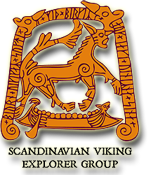History of SVEG
SVEG's more than 25 year history.
Summary of the association's history.
The association's origins are the excavations of the Viking-era wrecks in the entrance to Foteviken. Bjorn Jakobsen and Birger Enoksson with familiestraveled in caravans in the Vikings' footsteps. The group was expanded with Jackie Wahrgren in the mid 80's.
1987 laid the foundation of statutes of which Section 1 reads:
§ 1 The association role
Scandinavian Viking Explorer Group - abbreviated SVEG - is the a nonprofit organization with the purpose of studying, documenting and communicating our history, with particular focus on the Viking and Middle Ages.
The period between 1987 - 1994
The association consisted of about 60 active and 250 passive members. The main chore was the maritime archaeological work with survey and inventory of ship remains on the Falsterbo peninsula.
1993, Association SVEG, Falsterbo peninsula museum society and Vellinge municipality initiated the formation of the Foundation Fotevikens Maritime Center under the direction of Björn M Jakobsen. In the beginning, the foundation's mission primarily was to spread knowledge of the Nordic Vikings and the further development of marine archeology. 1995, the former head of the museum in Malmö, Sven Rosborn, was appointed as a scientific representative on the board. At the same time The Foteviken museum was created. Björn M Jakobsen became museum director and Sven Rosborn head of the information department at the new museum.
1994 - 2000
Association Svegs focus was now altered to being a supportive friendship association to the foundation with largely a non-profit input.
With Fotevikens Museum's development of the Viking town, the museum also developed the experimental archeology of iron, wrought iron, bronze casting, plant dyeing, tanning, especially the reconstruction of Viking Age boats, and sailing of these, in combination with the maritime work which is scanning the coastal waters after new ship finds and with Fotevikens Museum marine archaeologists investigating and documenting the shipwrecks in the area.
Association SVEG's activities followed this trend and the voluntary participants started living Viking life in the houses according to concept of living history and re-enacting.
Two medieval cogs were the results of the Foundation commissioned for the city of Malmö in the framework of a labor market project. Volunteers saw here an opportunity to get involved, and sailing these ships.
2000-2006
Association SVEG created the Towns team. The volunteers were given a set of rules to live by in the Viking town, to fulfill the conditions that a living history museum must offer.
Koggprojekt Phase 2 - City of Malmö's new assignment to the Foundation was to create a museum around the ships. This resulted in the Cog Museum, with the Middle Ages as a time carrier coupled to the two ships in Malmöya - the medieval harbour in Malmö. The concept included the involvement of volunteers, to participate in experimental archeology, bringing to life medieval ships and port environments, and of course sailing of the ships.
The Towns team has been active since 2001, the Ships team in Malmö was still in its infancy.
2008-2009
Ship's team participates in the museum business of sailing of the ships. They meet Wednesday evenings and Saturdays at Cog Museum. Ship's team was later expanded with the city team. City team participates in the medieval portenvironment Malmöya. They meet mainly on Sundays.
More than 25 years have passed since the association was formed. Björn and Birger remains at their posts as chairman and perpetual secretary. If we look to the association statutes, the business over the years has met all the goals that once were made. Nowadays, the Association's main mission is to actively support the experimental, and bring to life the museum’s activity. However, it is important to managing the business with an open mind and take the term towards new goals in order not to stagnate.


